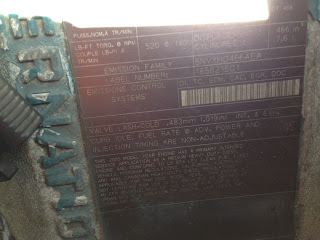I did a PM on the 2005 INTL 4300 with a DT466, an Allison 2200HS tranny, and a Spicer rear axle.
The MSDS for the oil was found on the Shell website by searching Rimula Premium Oil.
Filter LF9025
Rimula Premium Oil MSDS #400843L

There is a tag located driver side underhood that specifies exactly the type of oil that it was filled with at the factory as well as what is required for re-fill. It should be noted that there are multiple API categories, but only the ones that meet or exceed these requirements should be used.
This is straight out of the service manual that points at every part of the truck that requires scheduled preventative maintenance. I used this as a tool to help my eyes stay focused on what to look for while inspecting the truck.
I counted 17 zerk fittings throughout the truck.
However, since the brakes are hydraulic and the tranny is automatic I looked at the Kenworth and located the rest of the fittings, which include the ones pictured here that I noticed would be harder to locate. Especially while creeping under the truck.
Coolant MSDS # 1194E

Specifics for Belt Maintenance and Schedule
Air Filter indicator
Fleetguard AF257067
I think that having a good eye for preventative maintenance requires a lot of experience and patience, and is something that I hope to excel at. It is one of the most important jobs in the shop, if not the most important and should not be overlooked. Finding a procedure is the most efficient way to go about it. I started driver side front and looked over the exterior, sweeping into the hood then the cab, and around the truck and back under the hood. Same process for under the truck. Allowed me to take my time and not get distracted by bouncing back and forth like I am so prone to do.
Hours
Week: 30
Total: 335
















